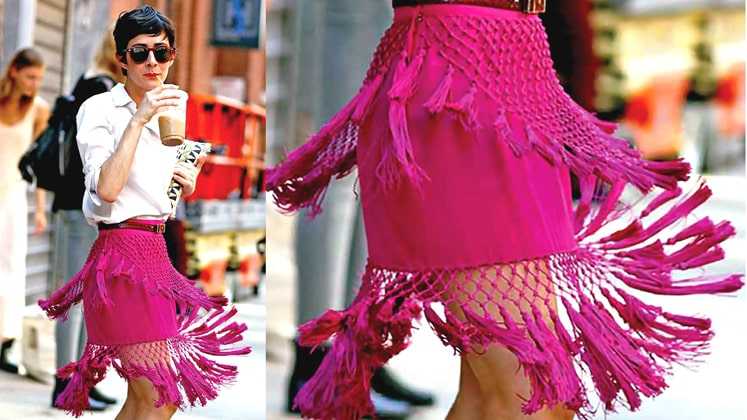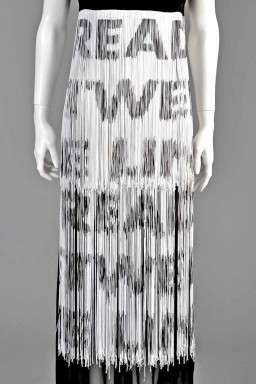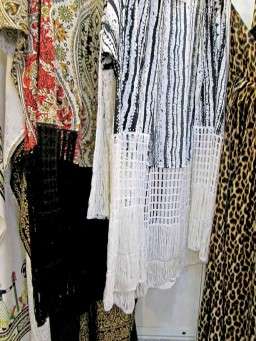
Fringes and tassels have been a decorative element since the ancient times, but were not popular beyond traditional American-Indian garments until it became the fashion rage on women’s cocktail dresses in the 1920’s and resurfaced as an iconic style in the 1960’s. After becoming a huge surface trend on bags, now we are witnessing fringing on every garment and home furnishing item possible. Seen on the runways and retails spaces in variety of interpretations ranging from fabric strings, braided and beaded, fringes have become a sought-after surface adornment amongst buyers this season. With many incorporating the fringes and tassels in the quintessential way, a few propulsive exporters also choose to exploit the trend in new and innovative ways…
Call it a trickle-down sparkling Gatsby effect, or popping tasselled trim, fringes of all sorts like leather fringe skirts, silky strings on boxy shifts or tassel-hemmed kaftans, are one of the most popular trends spotted in S/S’15. Gone into hibernation after the Spring/Summer’14, fringes re-emerged this summer in a more interesting and innovative manner. Explaining the sudden growth in demand for fringes, Manish Modiani, Director, SaiBa Expo said, “These days buyers are not very keen on buying expensive styles, therefore they are looking forward to buying styles which are less pricey but have an interesting surface ornamentation. And as fringes are able to provide just that, it is being used in almost all the styles.” The company caters to the women’s western wear segment and in their S/S’15 collection they are producing tie&dyed, washed and spray dyed fringes, solid coloured styles with two-tone dyed nylon fringes and two rows of knotting in the middle and kaftans with loop tassels.

Showing off their construes of this fluid and delicate ornamentation, designers such as BCBG Max Azria, DKNY, MSGM and Valentino, all featured several variations of the tassel in their Resort’15 collections. DKNY and Choe presented a range of dresses and separates with layered and bejewelled feather fringes and low pile height looped fringes on coats, while on the other hand, Hervé Léger by Max Azria, unveiled dresses and cover-ups in hand knotted fringes ending in large loops. MSGM and BCBG Max Azria, added a touch of handmade into their collections, by patching jacquard over the base and keeping the loose ends unfinished, dropping as a fringe. Camilla and Marc created two-tone dip-dyed and broad cloth-cut fringes over dresses and skirts, whereas doing it the generic way, TSE and Valentino added cut-fabric fringes in rectangular shapes on their dresses, without much ado.
Being an epitome of bohemian and tribal culture, fringes have gone past that phase when they used to be only popular amongst hippies. In the S/S’15 collections, fringes and tassels are being created in layered frill dresses and long loops created with assorted beads now seen thrown all over a skirt in uneven lengths. Diamond Overseas (India), who are into production of beach cover ups, kaftans, and kimonos, have been developing a lot of styles in fringes. “Tasselled and fringed kimonos are very popular styles in Europe, UK and US. Tassels and fringes have become a global trend as there is a noticeable revival of the 60s fashion. Fringes are being amalgamated with tone-on-tone prints and embroideries to create a simple but exquisite look,” explained Abhishek Kochhar, CEO of the company.
S.K. Dyeing & Printing Works, who are into delivering specialized dyed, and printed scarves and garments believe fringes to be a country-specific value addition trend. Elucidating more, Ishant Sadh, CEO

Scarves of the company, shared, “Buyers are demanding for products which are less expensive but have value addition, therefore our range of ombre dyed or marble dyed scarves are finished with decorative tassels on the edges. Yet, hand knotted tassels are not cheap, therefore the requirement for tassel differs from country to country. Buyers from France, Germany and Spain, like decorative tassels as a surface embellishment, but US and Canada are not so interested.”
Another reason for the growth of fringes as value addition is the fact that, prints, embroideries and beadings have become an over-exploited medium in our country, which makes buyers search for different options as replacements but maintaining the rich and festooned look. No wonder exporters are trying their best to impart newness in them. Rahul Sadh, CEO, The Design Sangrah, informing about their S/S’15 collection said, “As the prices are getting cheaper and MOQ (Minimum Quantity Orders) is also not a big issue, we have created a digital collection with fringes. We are playing with contrast colours and matching tonal colours as well. We are printing on fabrics and then cutting them to make fringes to achieve printed fringes, which is a different look.” Another company, Shivaka International is developing garments out of cut fabrics strips. The fabric strips are knotted in variety of knotting and tying styles like, the celtic knot, the panel knot and macramé berry and shell knots, till the required length (be it empire waist for vests or thigh length for dresses) and the rest leftover lengths are left as it is to fall as fringes.
Straight off the catwalks, the fringes are now moulded into distinct manners to suit buyer requirement by the exporters. Not just presented in the archetypical leather or suede variety, many exporters are now creating fringes in variety of fabrics and mediums like, viscose, cottons, linens, polyesters, and silk blends. Now being sported in an unfinished look or being teamed with precious stones – there are no limits to this new trend. Tops are cut into strips till the empire waist, patches are allowed to fray to give a fringed look, tassels are arranged on dresses in a particular design pattern, and fringes of different colours are aligned together to create a tier dress effect.
Jaipur-based Rupayan, getting inspired by the Red American-Indian, has developed a collection called “Spirit of America”, which comprises of many fringed and tasselled styles. Fabrice Capron, Designer of the company, explaining about the increased usage of fringes this season, says, “Since our inspiration is from tribes, fringe is one major key element seen in the tribal costumes, therefore, we have tried to incorporate it in different ways. We have used fringes by knotting and interlacing them in dresses and kaftan sleeves. If you see the big fashion designers, dolce and gabanna or others, they are using long fringes; therefore we also have to offer our customers a variation of a trend which is going on in high fashion segment.” No longer confined to Mid-west America, the fringes are going international and with growing prevalence and customary reoccurrence of this trend, fringes and tassels can definitely be called classics!

Post a Comment